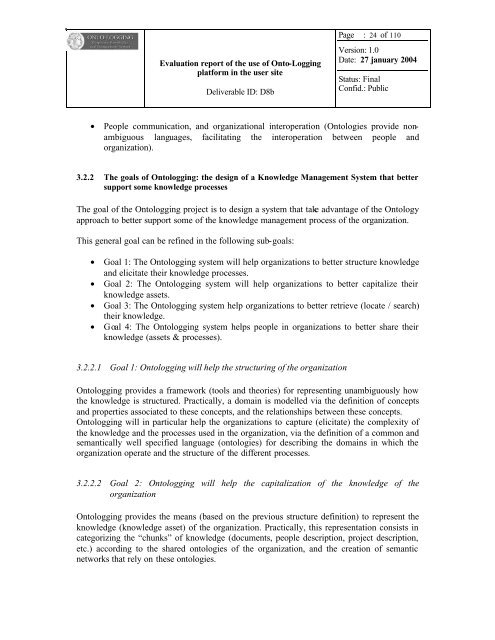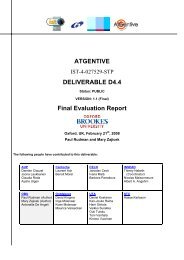pdf 820Kb - INSEAD CALT
pdf 820Kb - INSEAD CALT
pdf 820Kb - INSEAD CALT
Create successful ePaper yourself
Turn your PDF publications into a flip-book with our unique Google optimized e-Paper software.
Evaluation report of the use of Onto-Logging<br />
platform in the user site<br />
Deliverable ID: D8b<br />
Page : 24 of 110<br />
Version: 1.0<br />
Date: 27 january 2004<br />
Status: Final<br />
Confid.: Public<br />
• People communication, and organizational interoperation (Ontologies provide nonambiguous<br />
languages, facilitating the interoperation between people and<br />
organization).<br />
3.2.2 The goals of Ontologging: the design of a Knowledge Management System that better<br />
support some knowledge processes<br />
The goal of the Ontologging project is to design a system that take advantage of the Ontology<br />
approach to better support some of the knowledge management process of the organization.<br />
This general goal can be refined in the following sub-goals:<br />
• Goal 1: The Ontologging system will help organizations to better structure knowledge<br />
and elicitate their knowledge processes.<br />
• Goal 2: The Ontologging system will help organizations to better capitalize their<br />
knowledge assets.<br />
• Goal 3: The Ontologging system help organizations to better retrieve (locate / search)<br />
their knowledge.<br />
• Goal 4: The Ontologging system helps people in organizations to better share their<br />
knowledge (assets & processes).<br />
3.2.2.1 Goal 1: Ontologging will help the structuring of the organization<br />
Ontologging provides a framework (tools and theories) for representing unambiguously how<br />
the knowledge is structured. Practically, a domain is modelled via the definition of concepts<br />
and properties associated to these concepts, and the relationships between these concepts.<br />
Ontologging will in particular help the organizations to capture (elicitate) the complexity of<br />
the knowledge and the processes used in the organization, via the definition of a common and<br />
semantically well specified language (ontologies) for describing the domains in which the<br />
organization operate and the structure of the different processes.<br />
3.2.2.2 Goal 2: Ontologging will help the capitalization of the knowledge of the<br />
organization<br />
Ontologging provides the means (based on the previous structure definition) to represent the<br />
knowledge (knowledge asset) of the organization. Practically, this representation consists in<br />
categorizing the “chunks” of knowledge (documents, people description, project description,<br />
etc.) according to the shared ontologies of the organization, and the creation of semantic<br />
networks that rely on these ontologies.
















